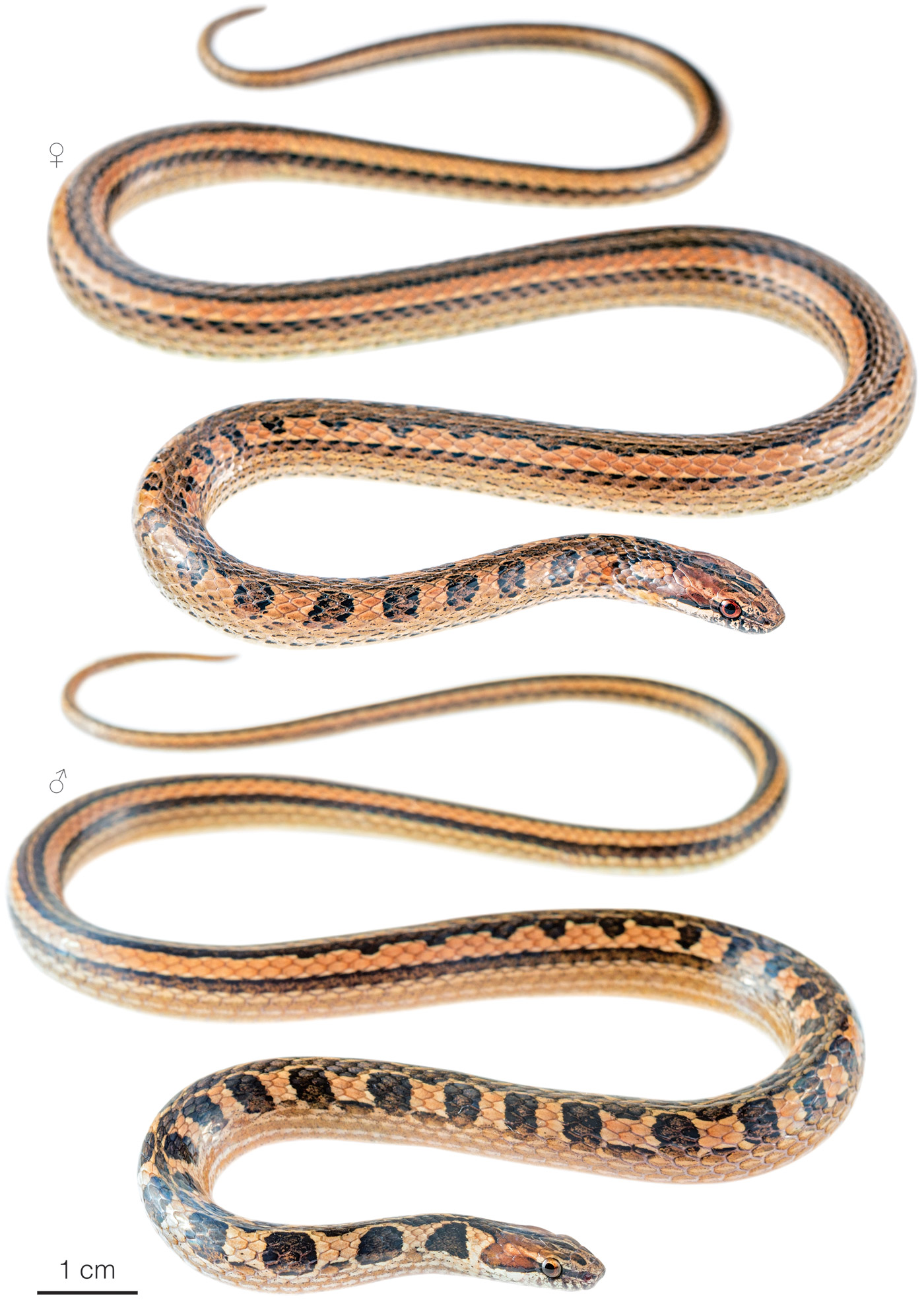Published March 21, 2024. Open access. | Purchase book ❯ |
Lonely Spotbelly Snake (Coniophanes longinquus)
Reptiles of Ecuador | Serpentes | Colubridae | Coniophanes longinquus
English common name: Lonely Spotbelly Snake.
Spanish common name: Culebra ventripunteada solitaria.
Recognition: ♂♂ 35.1 cmMaximum distance from the snout to the tip of the tail. Snout–vent length=22.5 cm. ♀♀ 42.2 cmMaximum distance from the snout to the tip of the tail. Snout–vent length=28.3 cm..1 Coniophanes longinquus is a small and slender snake that can be identified by having a tan brown dorsum with a series of dorsolateral black blotches that become merged into a pair of black stripes (Fig. 1). The head is rich reddish brown with a blackish irregular mark extending from the nape across the parietals and frontal.1 A black-lined pale cream bar extends from behind the eye across the temporal region.1 This species differs from C. dromiciformis by having well-defined dark spots on the anterior third of the body (lacking in C. dromiciformis).1,2

Figure 1: Individuals of Coniophanes longinquus from La Ceiba Reserve, Loja province, Ecuador.
Natural history: Coniophanes longinquus is a diurnal, crepuscular, and terrestrial snake that inhabits xeric ecosystems, including seasonally dry forests and shrublands. The species also occurs in areas having a matrix of coffee/banana plantations and overgrown fields with second growth forest.1,3 By daytime or during the early evening, these snakes may be seen crossing dirt roads or foraging on the forest floor, swiftly moving on leaf-litter or along dry stream beds.1,3 At night or during cold days, they remain hidden under tree trunks.4 Almost nothing is known about the diet in this species, except that one specimen had consumed a Desert Sticklizard (Macropholidus ruthveni).1 Spotbelly snakes are calm, jittery, and rely mostly on their camouflage and swift movements to avoid predation.3 They have a long, fragile tail that breaks off easily when grabbed by a predator, enabling the escape and survival of the snake.3 In Peru, four adult females of C. longinquus were found to contain 3–4 eggs, which probably corresponds to the actual clutch size.1
Conservation: Least Concern Believed to be safe from extinction given current circumstances..5 Coniophanes longinquus is listed in this category because the species is widely distributed, abundant in some localities, and its populations are believed to be stable.5 Although deforestation due to agricultural expansion is prevalent in its area of distribution, this is not considered a major threat to the species, since C. longinquus and its prey items appear to occur in high densities in agricultural landscapes.1
Distribution: Coniophanes longinquus is native to the Tumbesian lowlands and adjacent Andean foothills of southern Ecuador (Fig. 2) and northwestern Perú.

Figure 2: Distribution of Coniophanes longinquus in Ecuador. See Appendix 1 for a complete list of the presence localities included in the map.
Etymology: The name Coniophanes comes from the Greek konios (=dust) and phanion (=dim),6 and probably refers to the light spots along the belly of some members of the genus. The specific epithet longinquus is a Latin adjective meaning “outlying” or “remote.” It is used to refer to the outlying distribution of this species relative to other members of the genus.1
See it in the wild: Lonely Spotbelly Snakes may be encountered at a rate of about once a week in forested areas of La Ceiba Reserve. The snakes may be seen as they cross forest trails during sunny days.
Authors: Alejandro ArteagaaAffiliation: Tropical Herping (TH), Quito, Ecuador. and Sophia HurtadobAffiliation: Universidad ICESI, Cali, Colombia.
Photographer: Jose VieiracAffiliation: Tropical Herping (TH), Quito, Ecuador.,dAffiliation: ExSitu, Quito, Ecuador.
How to cite? Arteaga A, Hurtado S (2024) Lonely Spotbelly Snake (Coniophanes longinquus). In: Arteaga A, Bustamante L, Vieira J (Eds) Reptiles of Ecuador: Life in the middle of the world. Available from: www.reptilesofecuador.com. DOI: 10.47051/VPTD3022
Literature cited:
- Cadle JE (1989) A new species of Coniophanes (Serpentes: Colubridae) from northwestern Peru. Herpetologica 45: 411–424.
- Bailey JR (1939) A systematic study of the snakes of the genus Coniophanes. Papers of the Michigan Academy of Science, Arts and Letters 24: 1–48.
- Field notes, Reptiles of Ecuador book project.
- Pazmiño-Otamendi G (2020) Coniophanes longinquus. In: Torres-Carvajal O, Pazmiño-Otamendi G, Ayala-Varela F, Salazar-Valenzuela D (Eds) Reptiles del Ecuador. Museo de Zoología, Pontificia Universidad Católica del Ecuador. Available from: https://bioweb.biohttps://bioweb.bio
- Lehr E (2021) Coniophanes longinquus. The IUCN Red List of threatened species. Available from: www.iucnredlist.org. DOI: 10.2305/IUCN.UK.2021-3.RLTS.T203469A2765986.en
- Brown RW (1956) Composition of scientific words. Smithsonian Books, Washington D.C., 882 pp.
Appendix 1: Locality data used to create the distribution map of Coniophanes longinquus in Ecuador (Fig. 2). Go to the section on symbols and abbreviations for a list of acronyms used. Asterisk (*) indicates type locality.
| Country | Province | Locality | Source |
| Ecuador | Loja | Chaguarpamba | Reptiles of Ecuador book database |
| Ecuador | Loja | Reserva Jorupe | Reptiles of Ecuador book database |
| Ecuador | Loja | Reserva La Ceiba | Torres-Carvajal et al. 2019 |
| Ecuador | Loja | Río Malvas | This work; Fig. 1 |
| Perú | Cajamarca | Monteseco | Cadle 1989 |
| Perú | Cajamarca | Monteseco, 1 km NE of | Cadle 1989 |
| Perú | Cajamarca | Monteseco, 1 km NNW of* | Cadle 1989 |
| Perú | Cajamarca | Roadbetween Monte Seco and Udima | Cadle 1989 |
| Perú | Lambayeque | Área de Conservación Ñaupe | Online multimedia |
| Perú | Piura | Piura department | Calero et al. 2018 |